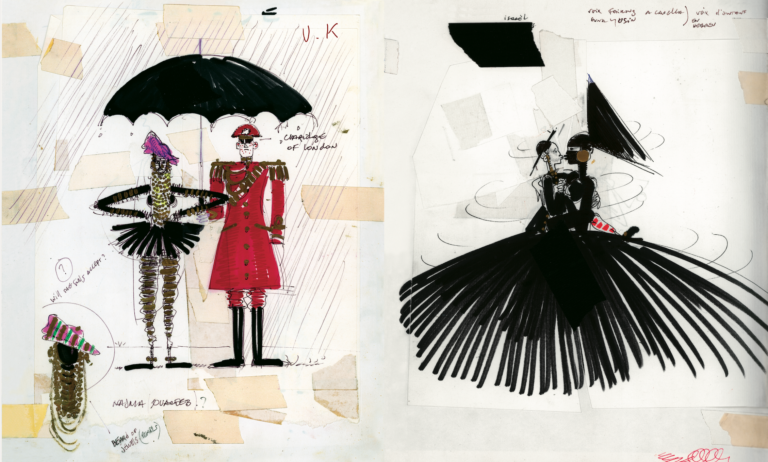Excess, colour, exaggerated hedonism: the 1980s changed the course of fashion history forever, irreversibly altering the balance of the global fashion business. The Eighties, destined to return cyclically in the fashion trends of the following decades were, in fact, a period of enormous changes whose consequences are still clearly perceptible. First and foremost, the stylistic (and economic) primacy of the fashion system shifted from haute couture to prêt-à-porter. An epochal passage that opened the doors to a plurality of styles capable of characterising the philosophy of the different brands. It is to the streets of New York, rather than to the salons of the Parisian upper middle class, that fashion addicts look, captivated by the myth of career, success, money and power that the American media show on a continuous cycle.
These are the years when the Young Urban Professionals, commonly called Yuppies, rampant and always impeccable young people, begin to make their success evident even in their everyday look. An affirmation that finds its absolute protagonist in the woman, rampant, aggressive, successful, happy to show even in clothing the new role represented within society. So, make way for suits with broad shoulders and strictly tube skirts, starched blouses in a masculine style and comfortable and elegant half-heels. The so-called 'Dress for Success', so dubbed by stylists such as Armani and Versace, who had their worldwide consecration in this decade: broad shoulders, therefore, for women, like those of men, testifying to their ability to face the great challenges of life and, at the same time, that position of power so longed for and finally earned.
The Musée des Arts Décoratifs in Paris celebrates the 1980s with a major exhibition entitled 'Années 80. Mode, Design Et Graphisme En France', which traces through seven hundred works – including clothes, design objects, furniture, posters, photographs, music videos, record covers and fanzines – the decade that resonated in Europe as a political and artistic turning point in the fields of fashion, design and music. The exhibition is punctuated by three themes that reflect the great variety of ideas and forms of those years: a new political and cultural era, the rise of design and the new course of the fashion system. It is no coincidence that the exhibition focuses heavily on the design/fashion dichotomy. The 1980s saw the birth of a new generation of artists elevated to superstar status, such as Olivier Gagnère, Elizabeth Garouste and Mattia Bonetti, Philippe Starck, in the field of design and stylists now considered mythological such as Jean Paul Gaultier, Thierry Mugler, Gianni Versace and Giorgio Armani. Just as homes are filled with furnishings chosen on the basis of their aesthetics not just their functionality, wardrobes too are beginning to be flooded with flashy, bright clothes in a triumph of youthful, trendy details that do not go unnoticed. Getting noticed is the lowest common denominator that accompanies the culture of the decade, overflowing in every element.
It is the consecration of the American myth that marks the definitive decline of the ideals of old Europe in the name of a pop culture that has in the art of Andy Warhol and Basquiat and in Madonna, the world icon of pop-music, its undisputed symbols. The fact is that in art, music, design and fashion, the Eighties are still an interesting phenomenon to study and take as a model. From museums to catwalks, the step is short. During the last New York Fashion Week, Tom Ford presented to the public a collection for Spring/Summer 2023 strongly inspired by the Eighties. Metallic clothes, sequins and highlights are worn with backcombed hairstyles and smokey eyes with a vintage feel.
Animal prints, classic Tom Ford dinner jackets and hyper-feminine dresses that follow the lines of the body also appear in the collection. These range from blazers in metallic fabrics with a masculine cut to bomber jackets covered in embroidery and maxi multi-coloured appliqués in a triumph of sequins, satin and luminosity. A glittering collection enthusiastically applauded, as chance would have it, by Madonna herself, who in the Eighties had made ripped tights, extra-large t-shirts, ultra-short leather jackets, maxi jewellery and exaggerated make-up her much-imitated style signature. From New York to Paris, the step is short. On the catwalks of Paris Fashion Week, Junya Watanabe's Spring/Summer 2023 women's collection. The Japanese designer's show is a riot of broad-shouldered tartan dresses, tulle assemblages, punk crests and a shower of chains and pearls covering clothes and shoes. A tribute to the British New Romantic of the Eighties revisited, however, in a contemporary key.



